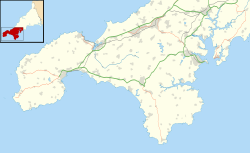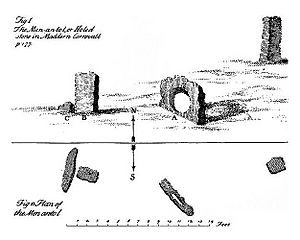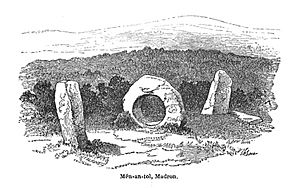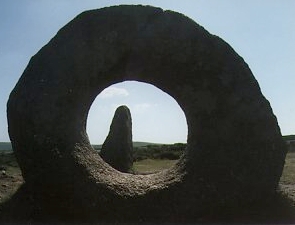Mên-an-Tol facts for kids
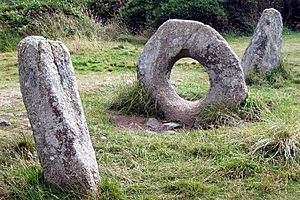
Mên-an-Tol in 2006
|
|
| Alternative name | Crick Stone |
|---|---|
| Location | Cornwall |
| Coordinates | 50°09′31″N 5°36′16″W / 50.1585597°N 5.6044974°W |
| Type | Standing stones |
| History | |
| Periods | Neolithic / Bronze Age |
| Site notes | |
| Condition | Good |
| Ownership | CASPN |
| Public access | Yes |
The Mên-an-Tol is a special group of standing stones in Cornwall, UK. In the Cornish language, its name is Men an Toll. People sometimes call it the "Crick Stone". You can find it about three miles northwest of a village called Madron.
Contents
Where is Mên-an-Tol Located?
The Mên-an-Tol stands close to the road that goes from Madron to Morvah in Cornwall. There are other old sites nearby. For example, the Mên Scryfa is an inscribed stone about 300 metres north. The Boskednan stone circle is less than 1 kilometre to the northeast.
What Does the Name "Mên-an-Tol" Mean?
The name Men an Toll comes from the Cornish language. It means "the stone of the hole". This name perfectly describes the most famous part of the monument!
What Does Mên-an-Tol Look Like?
The Mên-an-Tol is made of three tall granite stones. One stone is round and has a large hole in its middle. There are two other standing stones, one on each side of the holed stone. If you look at them from a certain angle, they look like the numbers "101".
The two side stones are both about 1.2 metres (about 4 feet) tall. The stone on the west side was moved after 1815. It was placed in a straight line with the other two stones. The holed stone is shaped like an octagon. It is 1.3 metres (about 4.3 feet) wide and 1.1 metres (about 3.6 feet) high. The round hole in the middle is 0.5 metres (about 1.6 feet) across. The only other stone like this in Cornwall is the Tolvan holed stone. You can see it in a garden near Helston.
There is also another standing stone nearby. Six other stones are lying down, and some are partly buried. A low, stony mound, which is a type of ancient burial site called a cairn, is just to the southeast. Two more ancient burial mounds from the early Bronze Age are between 120 and 150 metres to the north.
The Ancient History of Mên-an-Tol
People started studying the Mên-an-Tol in 1749. An expert named William Borlase was the first to investigate it. He drew a plan that showed the stones were not in a straight line back then. They formed an angle of about 135 degrees. Borlase also wrote that local farmers had taken some stones from the area. He was the first to write down the myths and rituals connected to the site.
In the 1800s, a local expert named John Thomas Blight published drawings of the site. He was the first to suggest that the stones might be what's left of a stone circle. Later, in 1872, William Copeland Borlase, who was related to the earlier Borlase, gave an even more detailed description of the area.
In 1932, Hugh O'Neill Hencken wrote the first modern report about the site. He thought the stones were not in their original prehistoric positions. He believed they had been moved a lot. He also thought the holed stone might have been part of an old tomb that was destroyed. People even told him that farmers with back pain would crawl through the hole to feel better!
In 1993, the Cornwall Historic Environment Service released a detailed report. They suggested that the standing stones were once part of a larger stone circle. This circle might have had 18 to 20 stones. They also thought the holed stone could have been part of a nearby portal tomb. Another idea is that the holed stone stood in the middle of the stone circle. It might have been used to frame important points on the horizon, like where the sun rises or sets. This kind of use for a holed stone is rare. However, the nearby Boscawen-Un stone circle does have a central standing stone.
Myths and Legends of Mên-an-Tol
Many people believe that the Mên-an-Tol has a special fairy or piskie guardian. This guardian is said to have amazing healing powers. One old story tells of a mother whose baby was a changeling. This means evil piskies had swapped her real child for another. The mother put the baby through the stone, and it helped her get her real child back! The ancient stones were believed to reverse the piskies' bad magic.
Local legends also say that if a woman passes through the holed stone seven times backwards during a full moon, she will soon become pregnant. Another old belief is that going through the stone can cure a child of rickets. Rickets is a condition that affects bones. For hundreds of years, children with rickets were passed naked through the hole in the middle stone nine times.


